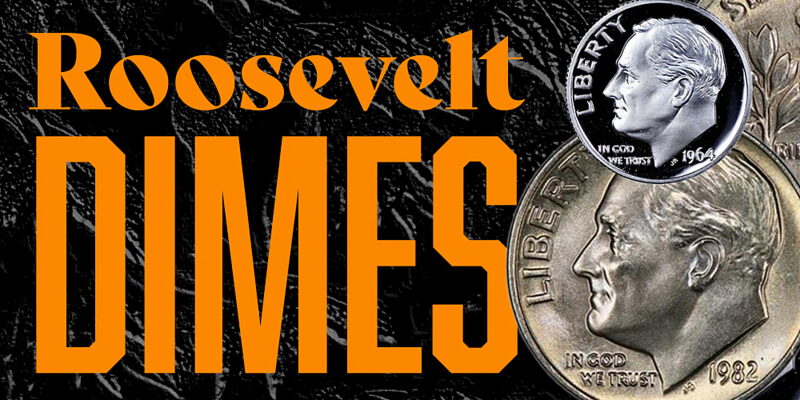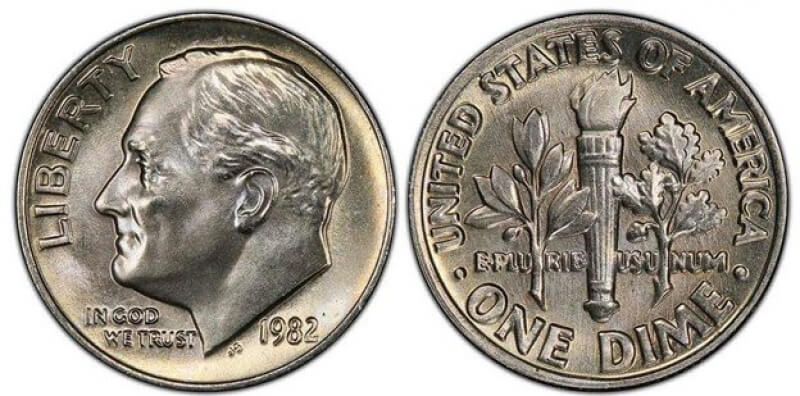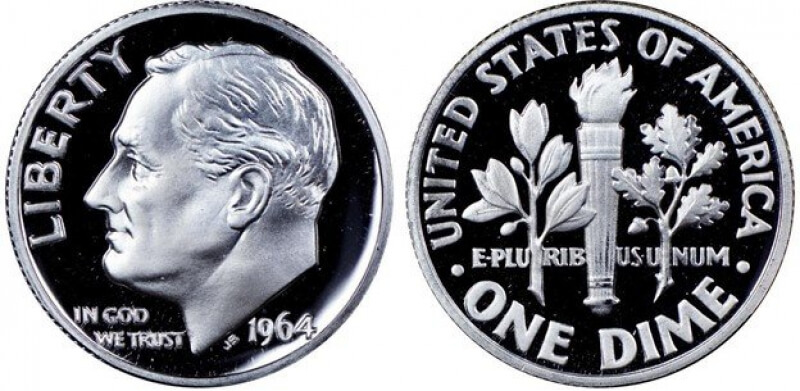
Roosevelt Dimes
By: Joshua Black – Joshua joined the ANA in late 2019. He collects 20th and 21st century U.S. coins, with an emphasis on Errors/Varieties and Franklin Half Dollars. He enjoys his pet snake Thomas Jefferson, and juggling.
The sudden death of beloved President Franklin Delano Roosevelt on April 12, 1945, was devastating for our nation. His passing was caused by a cerebral hemorrhage. Mr. Roosevelt was 63. He was diagnosed with polio in 1922, and that was the cause behind the loss of movement in his legs. He spent the rest of his life in a wheelchair.
When he passed away, it seemed fitting to honor him with a coin. Because of the U.S. Securities and Exchange Commission (SEC) Act 3510, the design of a coin can’t be changed without special legislation for the duration of 25 years. With the nickel having been changed in 1938, the quarter changed in 1932, and the dollar having not been made since 1935, the only possible choices would have been the cent, dime, and half dollar. As we now know, the dime was chosen to represent the fallen president. But why?
As stated earlier in this column, Franklin D. Roosevelt had polio. He spent time not taken up by the presidential office educating others about polio, and was an influential person garnering support for a polio vaccine. He organized the March of Dimes, which helped raise money for Dr. Jonas Salk to create the polio vaccine. The purpose of the March of Dimes was to have as many people as possible send one or more dimes to fund Dr. Salk’s research. It was a contribution even people in the height of the Great Depression could make.
By the end of the first month in January 1938, people all around the country had sent in 2,680,000 dimes, which adds up to $268,000. All of that went into funding the vaccine research. I’m sure Mr. Roosevelt would be happy to know that a polio vaccine is now available to consumers everywhere, and has been since 1953. Today, the March of Dimes is now an organization helping pregnant women and their infants prevent preterm birth, and maternal death. To learn more or to donate to the cause, visit marchofdimes.org.
The designer of the Roosevelt dime was John R. Sinnock. Mr. Sinnock also designed the Kennedy Half Dollar. The obverse features a bust of Roosevelt, the date, and, on the clad strikes, the mintmark. John Sinnock’s initials are located at the neck of the bust representing President Roosevelt.
The initials caused an outburst among the general public when the coin was first released. As this was the same time period as the beginning of the Cold War, the public thought the “JS” stood for Joseph Stalin, who was in the papers everywhere. The government attempted to convince the public that the letters were John’s initials, but it was never the most accepted belief in the first couple month’s after the coin’s release. It took time, but soon the public forgot about the controversy, and began to admire the dime’s design for the piece of art it is. But, as the saying goes, history repeated itself, and there was another Joseph Stalin outrage when the Kennedy Half Dollar was released.
The reverse of the Roosevelt dime features a torch with a flowing flame twisting to the right, along with an olive branch representing peace, and an oak spring representing strength on the opposite side. In addition to that, on the silver issues the mintmark is on the lower right side of the coin, to the right of the bottom tip on the torch. The torch is not seen on any other numismatic item made for circulation here in the U.S., making the reverse design one of a kind.
Roosevelt dimes offer many incentives in the way of collecting. There are 48 different date/mintmark combinations that are 90% silver. Although they are not large coins like Morgan Dollars, they are a lot more affordable. The key dates of the Roosevelt series are the 1949 P, D, and S, as well as the 1950-S, but none of the key dates for the Roosevelt series come near the value of any other 20th century key date coins (besides the Jefferson nickels).
The clad issues might actually be even harder to find than the silver issues in uncirculated condition because few dealers stock them due to their modest premium. Some clad dates also have weak strikes, so finding a nice example for a folder or album might be a challenge. Also, these coins would usually need to be found from circulation.
In most circumstances, quality MS-65 or higher specimens from the late ’60s and early ’70s will be a challenge to come by. Coins you will find in circulation will often be worn and automatically taken out of the mint state category. Finding mint state Roosevelt dimes will require patience to search through many circulating coins, or require time to find from dealers and coin shows. I recommend trying to get some dime rolls from banks and credit unions, as those will increase your chances of finding an acceptable specimen for your collection. Because of their comparatively low cost, affording a mint state circulation strike Roosevelt dime collection is within reach of any coin collector’s budget.
Collecting the proofs is another great way to assemble a set of this spectacular design. It is a shorter set (as there are not multiple mintmarks for each year), and a great one for those who want higher quality coins. The silver proofs were minted from 1950-1964, and the clad versions were minted from 1965 to present day. For the silver Roosevelt proofs, the key dates are 1950 and 1951. I recommend not collecting the full set of Roosevelt dimes in deep cameo (or dcam) as there is only one graded example of the ’52 in the dcam format. The clad proofs are much less expensive, with the key dates being the 2015 reverse proof and the 2015-W issue.
If you are collecting very high grade specimens and/or slabbed Roosevelt dimes, you might want to consider Full Bands/Full Torch. The former is a more popular term with Mercury dime specialists, but the designation also exists on Roosevelt dimes. Full Bands (FB) is the designation for PCGS slabs, and Full Torch (FT) designations were first put on slabs by NGC. Both designations began to be listed in slabs during April of 2003. Full Torch and Full Band coins are for higher budget collectors, as they are very expensive in the retail market. Some dates in Full Bands/Full Torch are very rare, and bring a premium when they appear on the market and at auctions.
There are some years of the clad proof issues that are lacking the typical “S” mintmark that is usually placed on Roosevelt proofs. These are towards the pricier end of the spectrum where Roosevelt dimes are concerned, but can add something extra special to your set to make it more interesting. The “no S” coins were minted in 1968, 1970, 1975, and 1983. To read more about the “no S” dimes, check out Sam Gelberd’s column in the August 2021 edition of The Numismatist (p. 19) “Treasures in Your Pocket.” These coins are usually found at large coin shows and auctions in slabs.
Sources:
Bressett, Kenneth. Whitman Guide To Coin Collecting. Whitman Publishing, LLC, 2018.
Yeoman, Richard S. A Guide Book of United States Coins. Whitman Publishing, LLC.
Gelbard, Sam. “Futile Pursuit.” The Numismatist (August 2021). “
Collecting Roosevelt Dimes” www.libertycoinservice.com
“Key Date Roosevelt Dimes: Collecting Tips” www.gainesvillecoins.com
“Full Bands or Full Torch Roosevelt Dime” www.rooseveltdimes.net


Photo 1 – PCGS graded 1982 No Mintmark MS-67 FB (Photo Credit: www.pcgs.com)
Photo 2 – NGC Silver Proof Roosevelt Dime (Photo Credit: www.ngccoin.com)